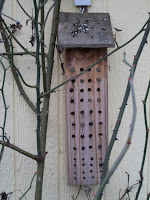There was this larger-than-ever growth in beekeeping starting in about 2006, when the first hubris over the Death Of All The Honeybees In The Universe began, along with subsequent publicity over CCD, Bayer pesticides and all of that. Well, now that all of us Newbeeks have kinda got our "feet on the ground" about the fundamentals of honey beekeeping, our attention has been expanding to include concern for all the pollinators in general -- from bats to birds, to other non-honeybee insects. I've noticed a growing interest in Mason Bees among all my fellow beeks here in the Willamette Valley. Lots of us are promoting their best interests here lately. It's not hard to raise and manage some. Look at our friend The Luddite's blog: her latest post has just a whole buncha really good stuff about Orchard Mason Bees. (You can also click on her blog over there to the left in our Bee Blog List to keep up with her thoughts.)
I actually started building Mason Bee houses before I began this odyssey into honey beekeeping. I give the bee blocks away whenever I can find any takers. This was because there was a year there when all of us noticed a distinct dearth of honeybees and seemed to observe a subsequent lack of blooms in our gardens. It seemed prudent to begin to do something about it. My oldest Mason Bee house is usually populated with several cocoons in the little holes. Here's a current picture of it, complete with bird-poop roof shingling:
 A close look reveals at least a half dozen full Orchard Mason Bee cocoons in the cylindrical holes I drilled. (There is a smaller set of holes below them for another variety of mason bee that I dunno the exact name of. The Leaf Cutter bees use 'em too. There are some full cocoons of theirs in this bee block as well.)
A close look reveals at least a half dozen full Orchard Mason Bee cocoons in the cylindrical holes I drilled. (There is a smaller set of holes below them for another variety of mason bee that I dunno the exact name of. The Leaf Cutter bees use 'em too. There are some full cocoons of theirs in this bee block as well.)The Mason Bee nesting blocks or houses are really easy to build (don't worry I'm not gonna post another long set of instructions, just go here - or here - if you wanna build some, or you can buy them in many garden stores and nurseries, or online).
The owner of the secretly-located feral bee grove puts me and most of the other bee house builders to shame. He has an absolutely amazing number of different shapes sizes and woods for Mason Bee houses, hung all over his garage, shed and behind his house. I'm hoping to get some good pictures this spring of all of them. It seems to work for us all, the Mason Bee population seems to be growing around here.
Seque: Since he asked very nicely, I promised Amy Leigh's boyfriend, Danny, that I would mention his article, 21 Things You Didn't Know About Honey Bees. The blog has been added to our Bee Blog List, as well. (I'm kinda hoping he'll link to us on their blog as well ....)
[May 2012 update: For a really informative, recent, discussion of solitary bee living quarters as well as a great tutorial on building nesting blocks go here to our friend The Luddite's blog.]



love your post and your bee house! the construction plan for the nesting block is great - and the Utube clip is just awesome. Off to the lumbar yard for me this weekend.
ReplyDeletethanks for the link to my blog!
You're welcome! You have a pretty good vid in your latest blog post, too!
ReplyDeletevery few people understands the importance of helping in the thriving of bee population. thanks for this post.
ReplyDelete